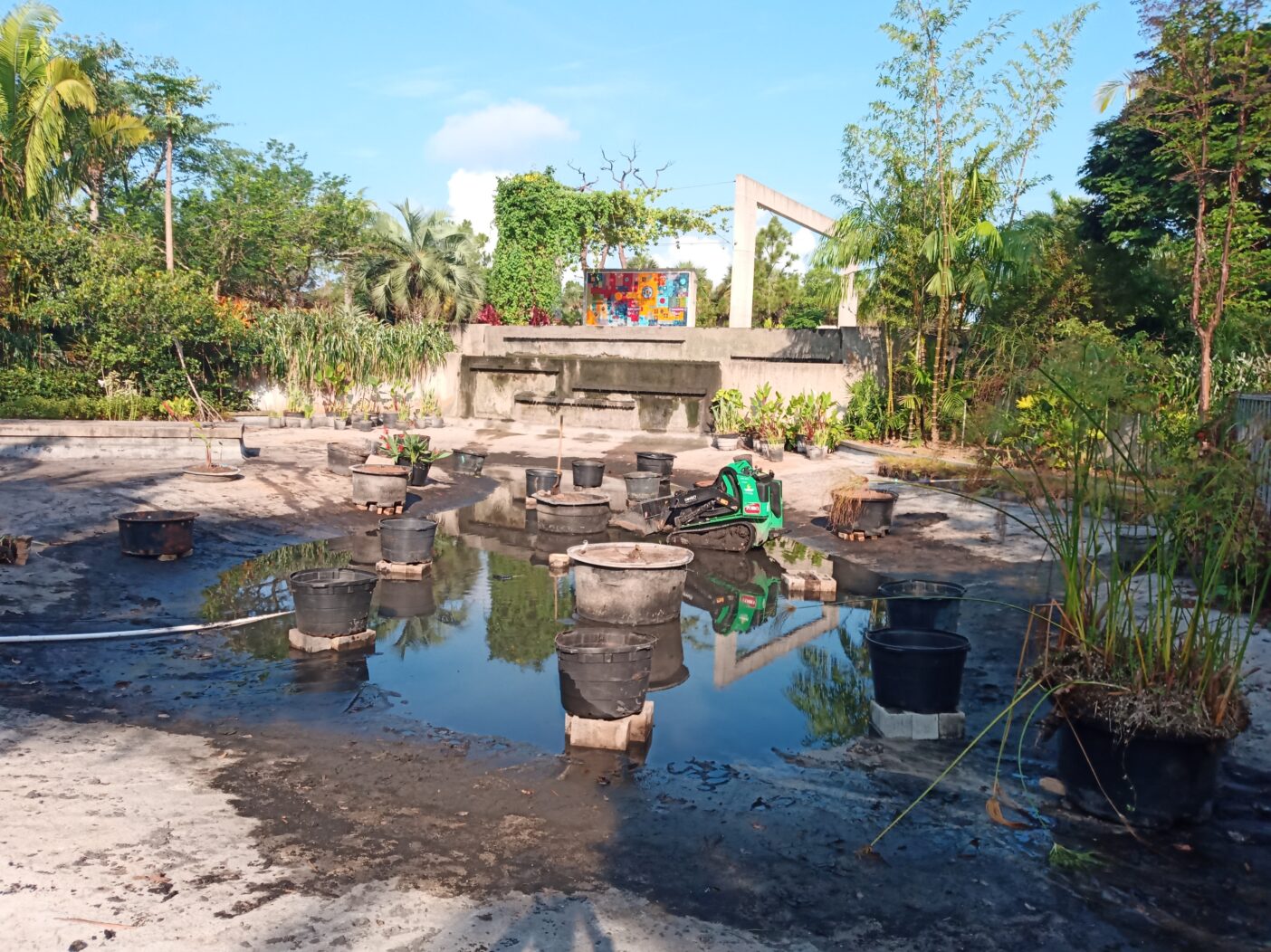
Mud bath, anyone?
For two weeks, members of our Horticulture Team stood knee-deep in mud as they drained all 100,000 gallons of water from the lower pond in the Kapnick Brazilian Garden for the first time in 10 years. They shoveled, dried, and hauled 2,500 gallons of the muck left behind. Yes, people, this is what goes on when the Garden is closed to guests! The team decided to make the best of our prolonged COVID-19 hiatus and take on big, messy maintenance projects. Draining these beautiful water features has its merits — think clearing opportunistic plants, invasive mollusks, and safeguarding the pools for those tending them — as we’ll learn later.

Once the water was drained, a thick layer of sludge coated the pond’s concrete bottom. Pushing the stuff to the water feature’s edge and loading it onto golf carts was arduous, even with the help of heavy machinery, recalls Danny Cox, Aquatic Areas Manager.

“When I would load the muck into the back of the golf cart with the Toro Dingo Compact Utility Loader (pictured, above) some of it would miss the golf cart and splatter onto the pier, then fly up and get all over me,” Danny recalls. A couple enterprising green herons waded in the newfound shallows a few feet away, eating all the fish they could cram in their beaks. Within the muck, small treasures were found: an iPhone, a pair of glasses, even the head of a sculpture from the Reflections on Glass: Fräbel in the Garden exhibition, an eerie half-smile still evident on its translucent face.

It hardly sounds like the pristine environs we know as the Kapnick Brazilian Garden, but sometimes improvements like these can literally require our staff to get in the weeds.
“We had planted some floating heart — Nymphoides aquatica — a native that is commonly seen in drainage canals throughout Southwest Florida,” explains Danny. “The plant propagates very easily and took advantage of the muck built up on the bottom of the pond. We were able to keep its growth in check, but if left alone it would take over the entire pond easily. In removing the muck from the pond, we are removing a lot of this plant.”
In other instances, removing invasive species is the impetus for draining water features. In 2015, an explosion of apples snails in the Water Garden and Lea Asian Garden’s Helen and Richard Thomas Lotus Pond devastated the collection.
“One adult snail could eat an entire pad of a waterlily in a day,” Danny says.
Last summer, staff drained the pond in the upper portion of the Kapnick Brazilian Garden, in the Burle Marx Plaza, for safety reasons — for people and plants alike. They filled pits originally built into the pond’s bottom for the waterlily containers. Some were just too close to the waterfall, pulling lily pads over its edge, and breaking them apart. Filling them in also made it easier for staff and volunteers tending the plants, removing that unexpected drop-off below the water’s surface.
The process this time around was time-intensive, strenuous, and — well, quite bluntly — yucky. After all, they were dealing with a decade worth of the stuff: a goopy mixture of plant debris, dirt, sand, clay from the potted plants, and mineral build-up.

And what about all that sediment once it was hauled away in Garden golf carts? It’s been set aside for composting. But first, Plant Health Specialist Cameron Cole is sending samples for composition and nutrient testing at the University of Florida. Once staff know precisely what is in the muck, they’ll have a better idea of just how to use it.
With the muck gone, staff are reflecting on the planting strategies that have worked well, experimenting with giant papyrus (Cyperus giganteus), the New World relative of the variety Cyperus papyrus, “Little Tut,” which you may have seen in planters along the Water Garden Stage and in the Water Garden. They plan to grow more canna varieties and use large pots for giant water platters (Victoria amazonica).
For more details on what you can expect during a Garden visit, as well as reopening updates, please check our Plan Your Visit page.

About the Author
Jenny Fuentes is the Content Manager at Naples Botanical Garden. She is a communications professional with experience in the nonprofit and higher education arenas. It’s the thrill of a good story that keeps her anchored to this profession.

